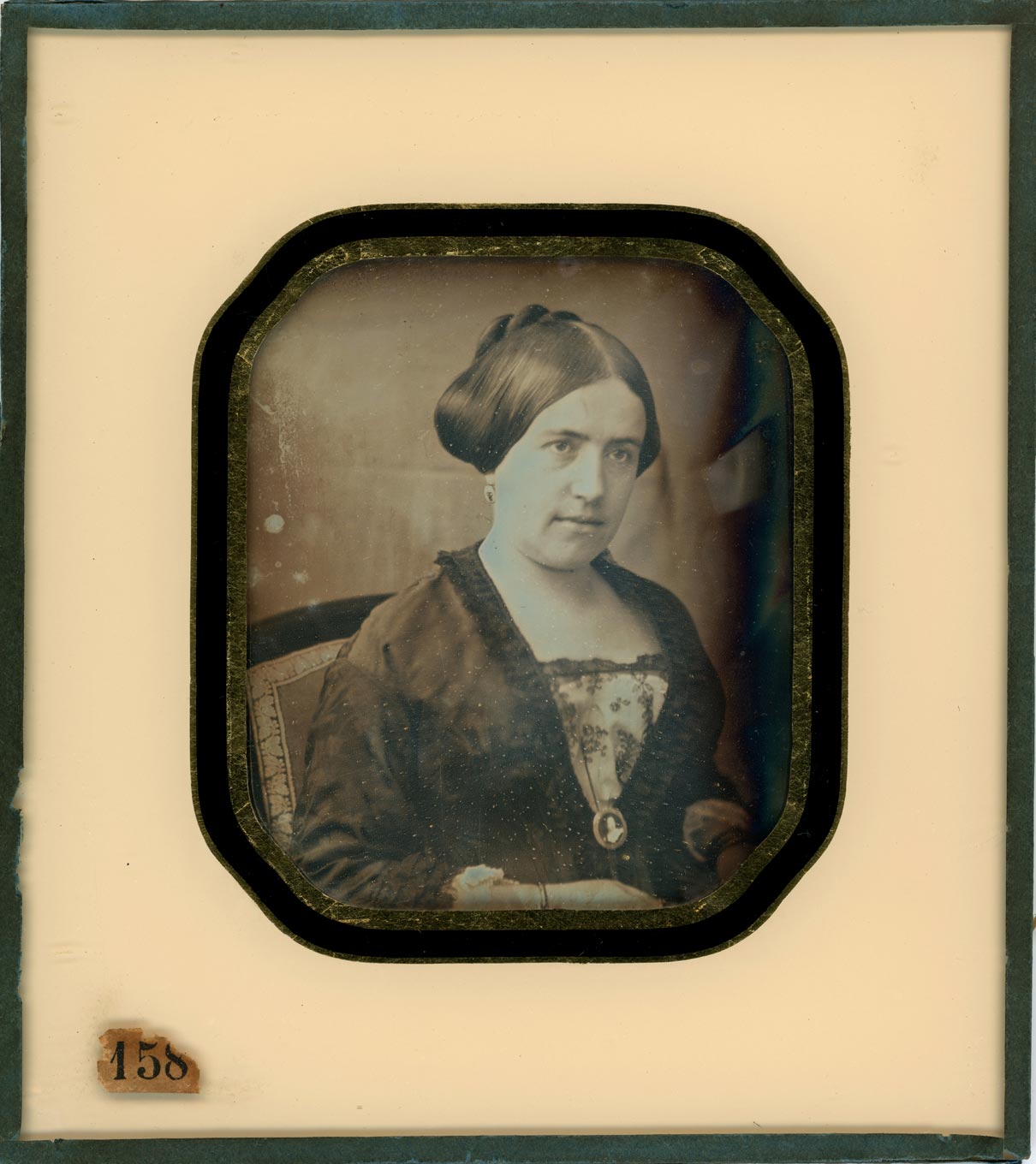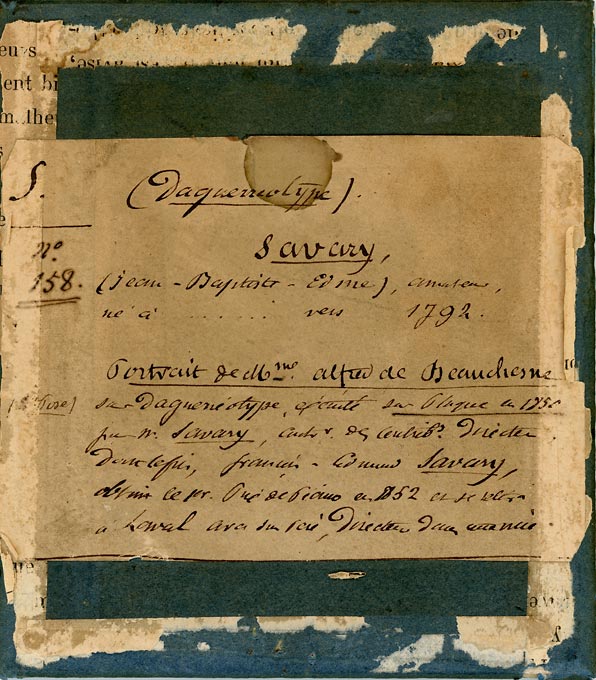A SECOND LEASE OF LIFE – SITTERS AND PHOTOGRAPHERS
In Mexico it is believed that a person does not really die until their name is spoken for the last time. I must say I like the idea since it seems to give some purpose to the articles I write. As a photo historian I love digging the past and finding out information not only about the photographers and their work, but also about the sitters whose likeness they took. This is what decided me to write this column, to drag these little known people from oblivion and give them, so to speak, a second lease of life. They may not have made history or become famous but they lived on this earth at some point, loved and were loved, laughed, cried, had fun, suffered, took photographs, or sat for them. This, in my opinion, is enough to make them worth being remembered.
PART ONE
Mrs Alfred de Beauchesne (sitter) and Savary (photographer)
Bruno Tartarin, a photo dealer who also happens to be a good friend of mine, recently sent me photos of some images he had in stock. Among them was a nice daguerreotype portrait of Mrs Alfred de Beauchesne by an amateur photographer named Savary. I was attracted at once by the image but even more so by the snippets of information written on the back of the plate. For some strange reason I felt I had to find out exactly who the model and the photographer were. I consequently bought the image, started doing some research and here is what I found.

Mrs Alfred de Beauchesne was born Nathalie Marie Martin at Auray, Morbihan, Brittany, on September 8th 1817. She was the daughter of Jacques Augustin Martin (1774-1840), a merchant and deputy mayor of the town of Auray, and of his wife Anne Armelle Lauzer de Kerzo (1776-1827). I am sorry to say that, apart from the fact she was educated at the Sacré Cœur of Quimper I do not know anything about the childhood and teenage years of Miss Martin who must have left Auray at some point and moved to Paris where she met Mr. Jean-Marie Anax Dubois de Beauchesne, the secretary of the Conservatoire Royal de Musique et de Déclamation, whom she married on March 28th 1837 at the mairie of the former eleventh arrondissement. The bride was just under twenty years of age, and the groom was thirteen years her senior, having been born at Lorient, Morbihan, on September 18th 1804.
Both the bride and the groom had already lost one of their parents. Nathalie Martin’s mother had died at Auray on March 14th 1827 and Mr Dubois de Beauchesne’s father had passed away at Versailles on March 21st 1835. Although the groom’s legal first and middle names were Jean-Marie Anax, he was always referred to as Alfred Dubois de Beauchesne, or simply as Alfred de Beauchesne, and if you do not mind, we will do the same. Less than a year after their wedding Mr and Mrs de Beauchesne were blessed with a daughter, Anna Marie, born at her parents’s home, 11, rue du Faubourg Poissonnière on June 5th 1838. On March 25th 1840, Mrs de Beauchesne’s father passed away, aged sixty-six, at Auray. On May 5th 1844 Mrs de Beauchesne gave birth to a son who was named Gustave François Marie. He died just over a year later, at Auray, on 23 July 1845. Another son, named Gaston Joseph François, was born at Paris on 30 June 1848 but passed away at Enghien, on 12 June 1849, aged eleven months.
There were no other children after that and in 1850, when her portrait was taken, Mrs de Beauchesne only had one child left, her daughter Anna. Mother and daughter must have been photographed on the same day or at least around the same time as there exists a daguerreotype portrait of Anna de Beauchesne, by the same amateur photographer. It was in the same auction as her mother’s photograph but in a different lot and was not bought by the same bidder, which means that mother and daughter are now separated, which I find very sad. There is, however, a painted portrait from around the same period where both mother and daughter are pictured together. It was made by Italian-born French artist Tito Marzocchi de Bellucci (1801-1871) and was sold at the same auction as the daguerreotypes in 20201Here is a link to the auction house website where you can see the painting: http://www.svvfarrando.com/lot/103484/11751127. It is a very pleasant image showing Mrs de Beauchesne seated in an armchair with her right elbow resting on one of the chair’s arms. Her left hand is touching her cheek and her left arm is around her standing daughter’s waist. Both mother and child are looking at the viewer with a smiling expression on their countenance. Anna, wearing a white dress, is holding a book or album.

Just over ten years after the photograph was taken, on August 8th 1861, Mr Alfred de Beauchesne was made a Knight of the Legion of Honour. On February 6th 1868, Anna Marie Dubois de Beauchesne married Stanislas Louis François Marie Chevrier, an employee of the Home Office where he was working as a telegraphist. The groom, born at Redon, Ille et Vilaine, on February 22nd 1845, was seven years younger than the bride. Moving fast forward the next major event in the life of Mrs de Beauchesne was the death of her husband on November 26th 1876 in the 8th arrondissement of Paris. He was only fifty-nine years old. On July 29th 1886, Nathalie Marie remarried. Her second husband was Count Henri Jean Marie de Massol de Rebetz (1825-1898) and the wedding took place at the mairie of the 8th arrondissement. Nathalie’s second marriage lasted for just under ten years. On February 18th 1895, while taking the sun at Monte Carlo, Monaco, the Countess de Massol died in her hotel room. Her second husband survived her by three years and passed away at Busloup, Loir-et-Cher in February 1898. Her daughter Anna lived until 1925 but she lost her husband in June 1895, a few months after her mother died.
It is now time to have a look at the amateur photographer who took that beautiful portrait of Mrs de Beauchesne and the equally nice portrait of her daughter Anna when she was eleven years old. The information on the back of the daguerreotype gives the name of the artist as Jean-Baptiste Edmé Savary and his date of birth at some point around 1792. Actually, Jean-Baptiste Edmé Savary was born at Monthermé, Ardennes, on January 15th 1803 (25 Nivose an XI in the revolutionarly calendar) to Jean François Edmé Savary and Marie Joseph Odiardi. His father, a Major in the army and a Knight of the Legion of Honour, died at Monthermé on October 22nd 1814. Jean Baptiste was just over eleven by then and it is most probable that he had to find an apprenticeship or a job at a very early age. On March 20th 1834, Savary married Magdeleine Victoir Dupont, a thirty-six year old widow, at the mairie of Sedan, Ardennes. He was by then a tax officer, a job he would keep until his retirement in 1860, by which time he had reached the position of Director of the French Treasury for the département of Mayenne.
On 18 November 1834 their only child, François Edmond, was born at Torcy, near Sedan. The boy proved to have an exceptional musical talent and was, by the age of five, a composer and a player. When he was twelve François Edmond had an accident that compelled him to use crutches for the next eight years and left him in a delicate state of health. In 1848 the Savarys moved to Paris when their son was admitted to the Conservatoire, the equivalent of the Royal Academy of Music, where he soon competed for the much desired Grand Prize. He came second in 1850 and first two years later, in a tie with George Bizet, of later Carmen fame. It is most probably during this period that Mr Savary made the acquaintance of Alfred Dubois de Beauchesne, the Secretary of the Conservatoire, and, through him, of his wife Nathalie and his daughter Anna. It is not clear when Jean Baptiste Edmé Savary came to be interested in photography nor how long he practised the art of Daguerre but his two known portraits show beyond doubt that he had mastered the technique. I wish more images by his hand could be traced2 I cannot but wonder whether Savary also took a photographic portrait of Mr. Alfred de Beauchesne and if so, where that portrait can be. Did he also take at least one self-portrait ? It would be nice to see what he looked like. and clearly attributed and that more information could be found about his photographic work. In the early 1850s Savary was appointed Director of the Treasury of the Mayenne département and settled in Laval. He stayed there until 1860 and retired in Saint-Servan, Ille-et-Villaine, where his son married Valentine Marie Anne Hieronimus, a twenty-four year old piano teacher, on July 25th 1860. Savary and his wife remained in Saint-Servan for the rest of their lives. Mrs Savary died there on September 21st 1873 and her husband followed her to the grave on June 22nd 1887. He was eighty-four years old. François Edmond Savary left Saint-Renan soon after his mother’s death and settled in Jersey where he stayed until 1890 before moving to London. His marriage ended in a divorce on July 25th 1889 and he died in London in February 1904. By the time of his death he was known as Edmond Savary d’Odiardi, had inherited the title of Duke of Rovigo from an Italian branch of his family, and was very much into science and more especially into the treatment of diseases by electricity, a subject he lectured on and wrote articles about.

